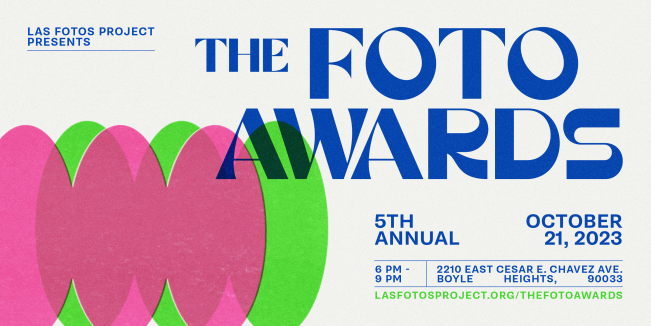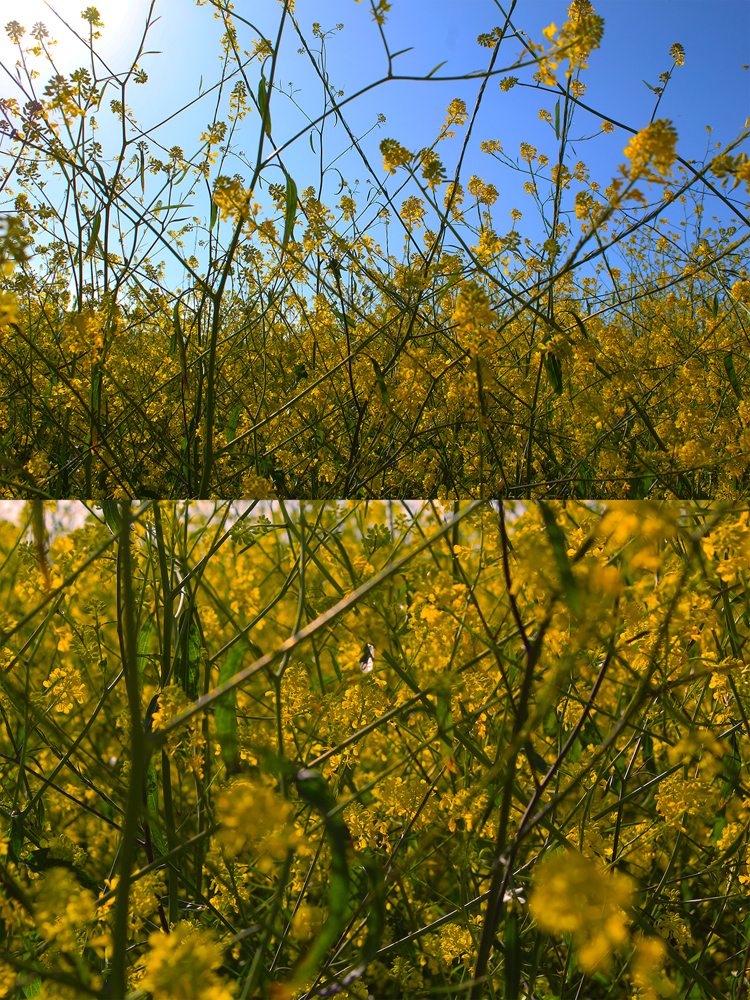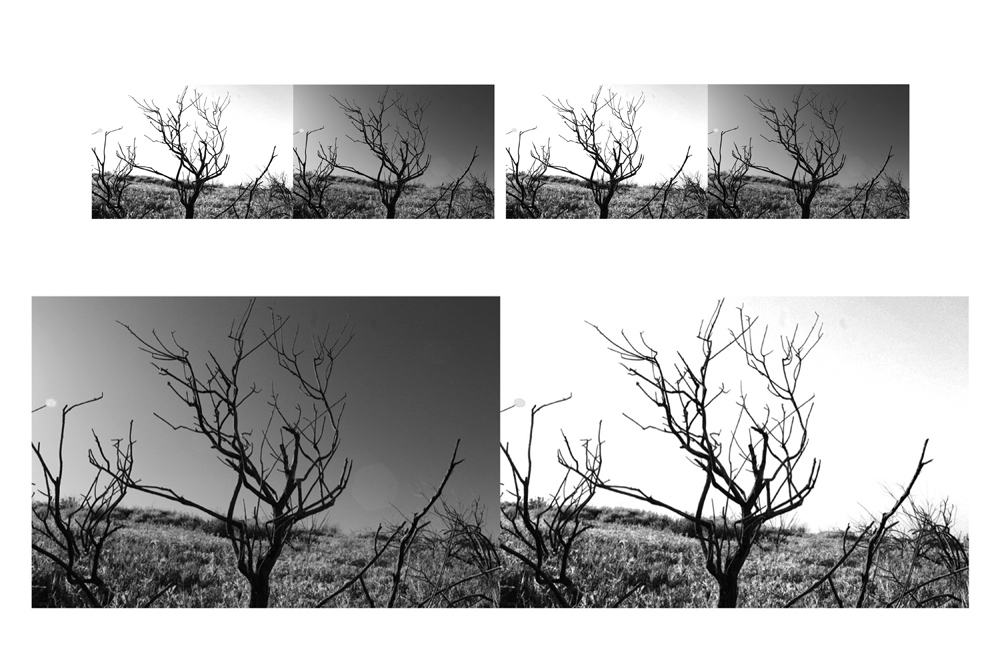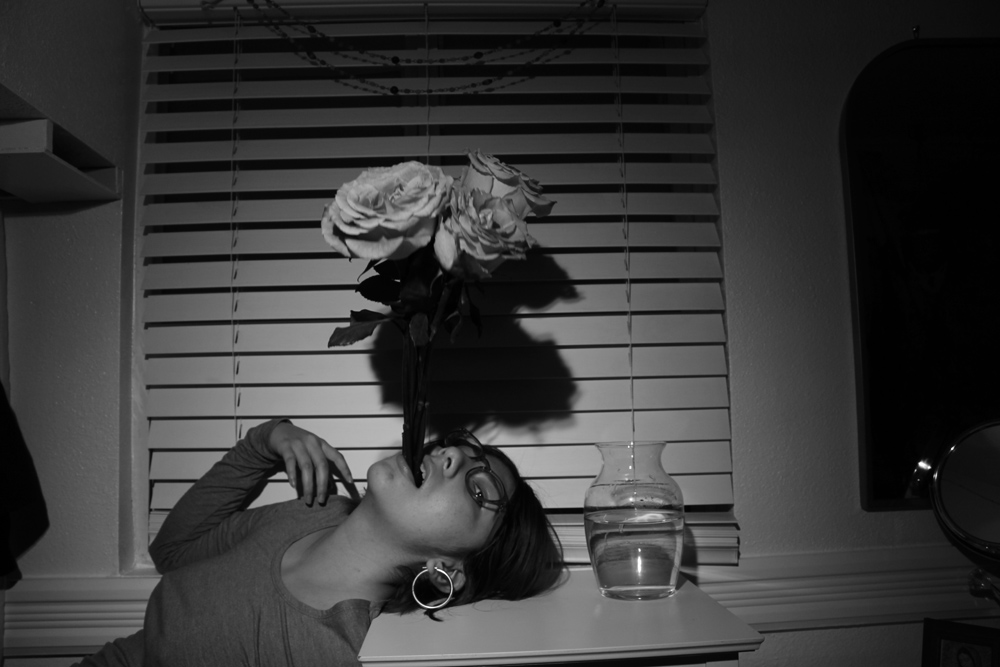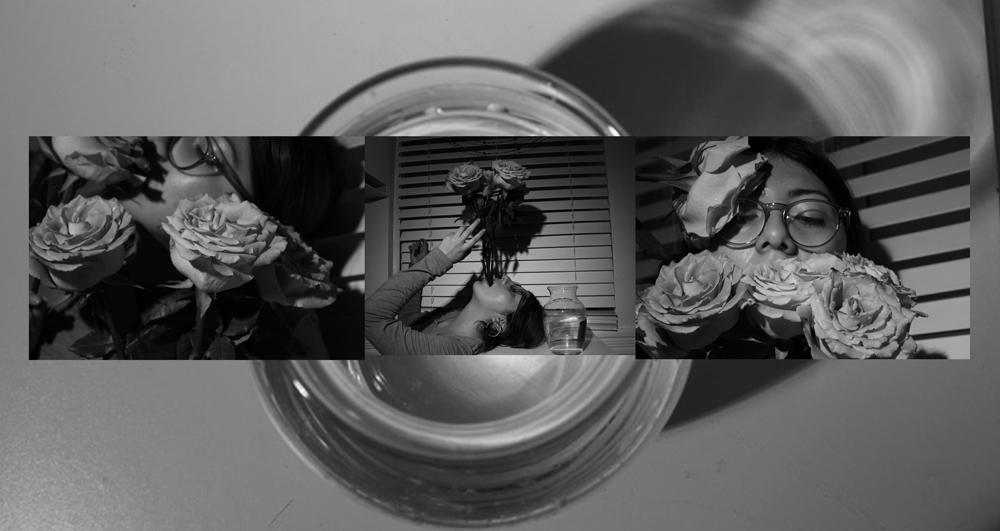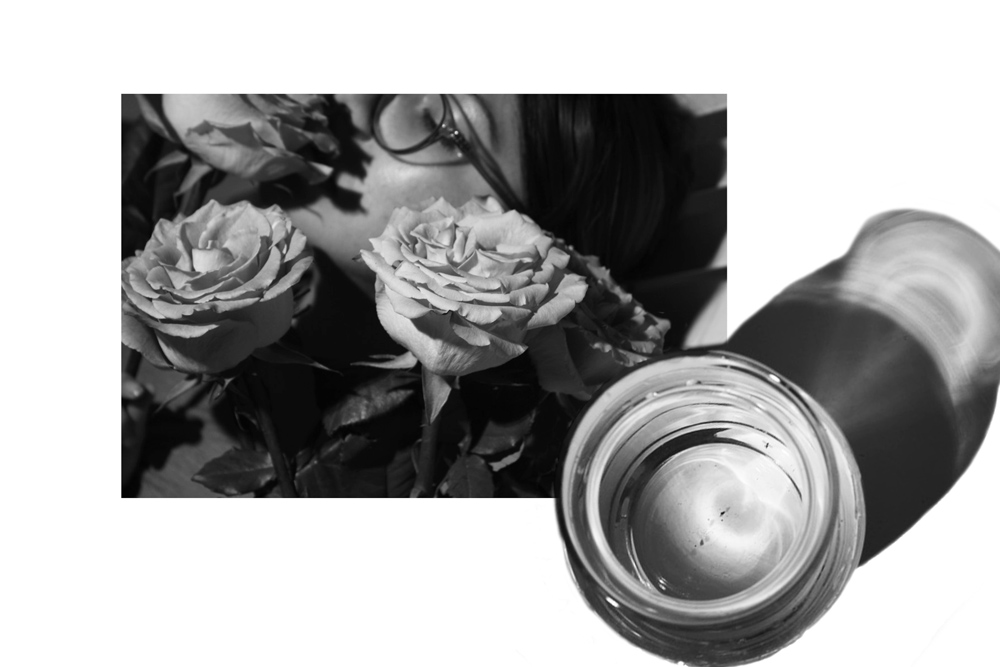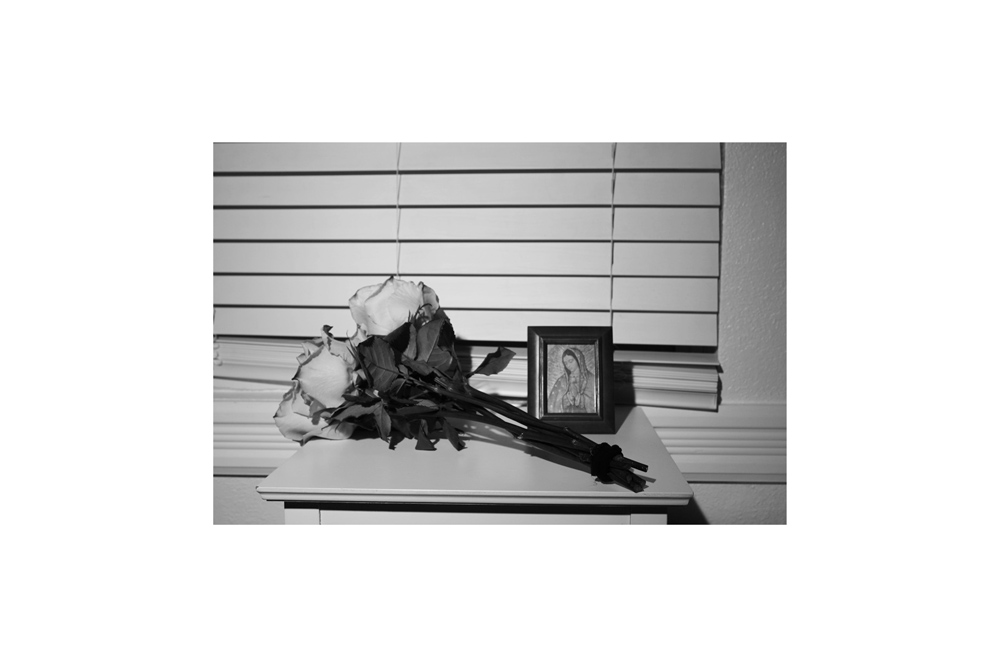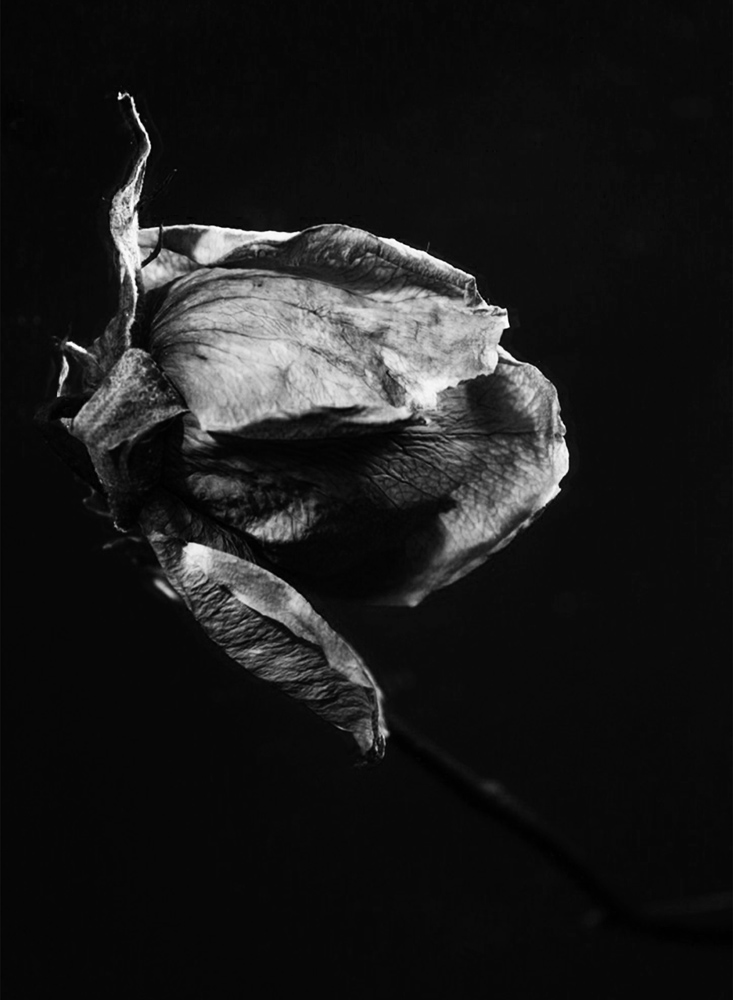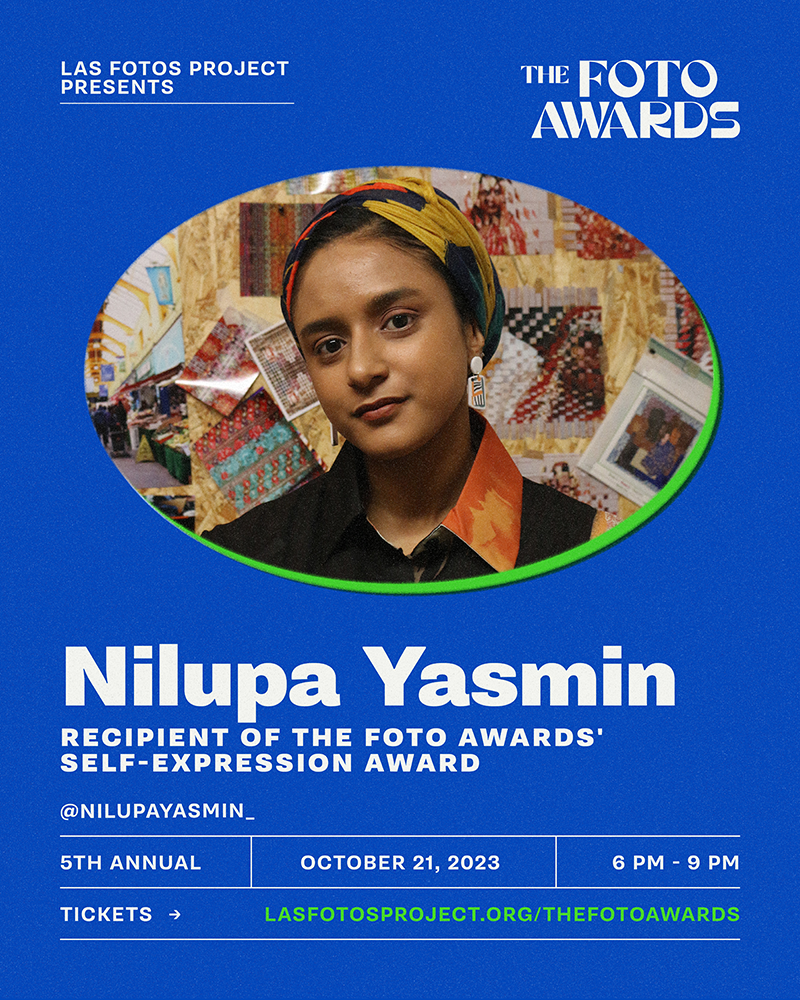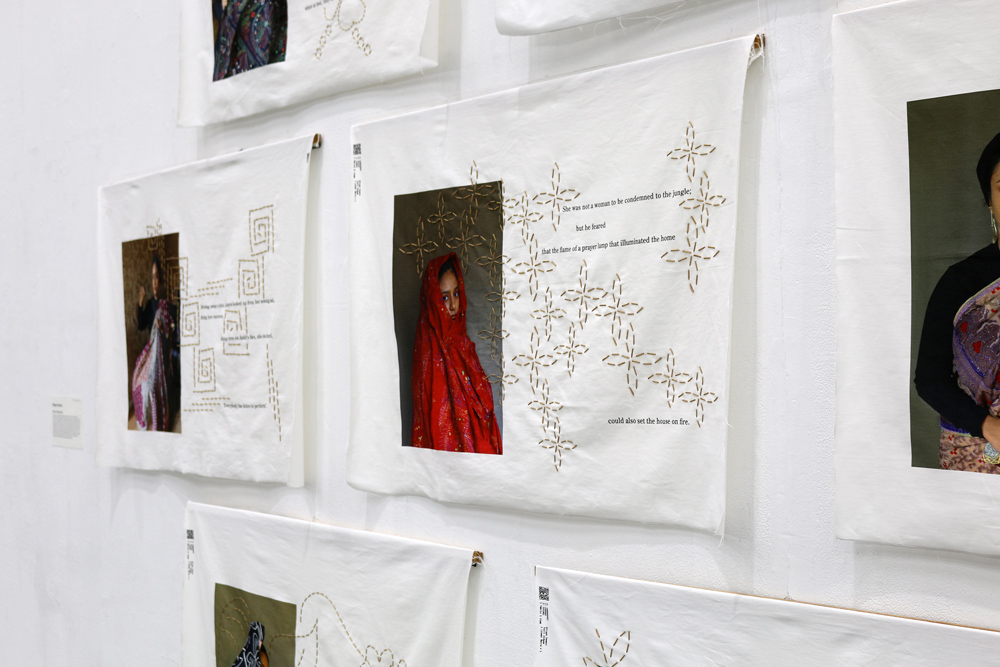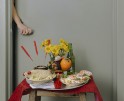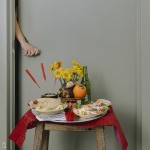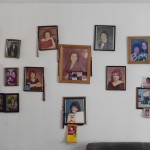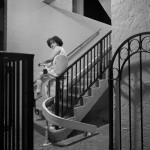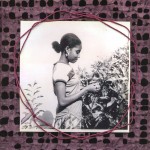Las Fotos Self-Expression Awardees: Nilupa Yasmin and Alé Rivas
This year will make the 5 th year of Las Fotos Project’s annual Foto Awards. The Foto Awards is Las Fotos Project’s Annual fundraising party & celebration recognizing women and gender-expansive photographers from around the world. This incredible event features a silent auction of photographs from emerging and established photographers across the globe, an award ceremony, and a community connecting space for artistic innovators community advocates and entrepreneurs, and more. The 5th Annual Foto Awards takes place on October 21st 2023 and if you are in Los Angeles, we encourage you to come!
Each year, three adults and three youths are awarded in the following categories: Self-expression (for bravery in creative expression or personal narratives in photography); Advocacy (for power in photojournalism or use of photography for community advocacy & social justice); and Catalyst (for those who are purposefully disrupting mainstream photography).
In this interview, I am thrilled to celebrate the Foto Awards 2023 Self-Expression award winners: Alé Rivas and Nilupa Yasmin.
In this interview, the awardees provide insight into their inspirations, experiences, and personal growth that have all woven together to form the artistic narratives and voices that they have today. I wish the warmest congratulations to Alé and Nilupa whose exceptional work has earned them their well-deserved recognition and prospective Foto Awards.
What emotions did you experience upon being notified that you were a 2023 TFA awardee?
Alé: I really was not expecting it. I remember being notified that I was nominated for the award. I thought that by itself was major and didn’t think much of it after that. So actually becoming an awardee all I could feel was love.
Nilupa: I felt gratitude for the recognition in my work and to see the category, falling under self expression, which is personal and important to me and the work I am making.
What and who are you inspired by as an artist
Alé: Everything around me is inspiration. I am so incredibly lucky to have found an amazing support system where I can explore and learn. My friends and siblings are some of the most talented people I have encountered. I have nothing but sincere love for every single one of them. Through their lives I have been able to see beauty wherever I go. Constantly being surrounded by remarkable talent and passion. I admire all the souls I have encountered throughout my lifetime. Being able to live and just experience those around me is what makes me an artist.
Nilupa: I feel my own experiences have inspired me first and foremost to make work. I often find myself wanting to explore themes that bring both a personal conflict and curiosity in the things I see around me. As far as other artists go, I am fortunate to have been exposed to so many different artists who work as image makers but also crafters, painters and sculptures. An all-time favourite would be Raisa Kabir, an interdisciplinary Artist, Educator and Weaver. Her work talks about colonial legacies and I’ve always been in awe with her work and the immaculate way she is able to create such powerful conversations surrounding it. Recently I visited the Carrie Mae Weems show at the Barbican Centre and revisiting her work has opened up so many thoughts in my mind about the work I want to keep on making. There are many to name, but my practice having a mixed medium element has influences from the work I’ve been exposed to.
In your work, you have a very profound way of expressing your emotions through photography and text in a way that offers a sense of belonging to other viewers. I’m curious to know how photography has impacted your sense of belonging in your personal life and how your journey has been with working through isolation and loneliness.
Alé:It has barely been a little over a year since I started my journey with photography. At first I really didn’t know that it was even possible to capture such life through a photo. I was taught how to use a camera by an amazing teacher who supported every îdea I had. I have always been drawn to self portraiture because of how intimate the process is. The more and more I did this the more confident I was with expressing myself. When I saw myself in my pictures I did not focus on any imperfections or problems in my life. All I would see is art. Not just any art, but something I created. Through photography I have gained a level of confidence and self love that only pushes me to becoming the best person I can be. When I put myself as the center of my work I become aware of what I have lived through. I have to understand and reflect certain times of my life in order to properly represent it through any creative work. Photography has given me so many opportunities to open up.
I find it very powerful how you incorporate a variety of materialistic approaches to creating work that shares the voices of the individuals that you are collaborating with and it has me curious about your process. What is your approach to working collaboratively with other people? Is there a collaboration(s) that sticks out to you as being pivotal in your life and career?
Nilupa: The first and foremost thing to remember when working with others is to respect their boundaries and limitations. Going into an environment where you have the intention to make work about others, with them or even for them, has to be initiated with an element of trust and care. I can’t stress how important that is, especially when you’re using your camera to tell the story of another. I’ve been fortunate to have experienced working with individuals who identify from many different age groups, demographics, cultural backgrounds and each time it’s a wholesome experience to learn from. My most favourite participatory project so far has to be my On Our Way Bus stops, where I converted bus stops along the iconic 74 bus route into galleries on Soho Road in Birmingham. It’s a reflection of how the 74 is a bus route that has barely changed, but the buildings and people who use it have. No matter where you go, the bus will always be on our way. Reflecting on how buses continued to run throughout lockdown, ensuring hundreds of thousands of key workers were able to get to work. The pandemic experience is one episode in its long history. So to celebrate the local people who make up the area, I worked with 7 different groups, each bus stop gallery reflected the character and soul of its surroundings. These bus stop galleries are reflecting the past and present of those who make up the local community, and designed with them too. The stained-glass style wrapping for each bus shelter tells a different story about the area and its people and celebrates North Birmingham’s reputation for migration and activism.
What advice would you leave for aspiring and emerging artists?
Alé: We are constantly growing. I still consider myself a beginner. I have a lot to learn, but what I can say is to never stop. Being an artist isn’t about how much work you have created or what you have done. Emerging or aspiring doesn’t change the fact that you are an artist. No one can take your talent away from you. Carry yourself with pride.
Nilupa: Don’t be afraid to try new things. We are our own worst critics and I see that a lot in myself and the students that I meet. If something matters to you, it’s worth making work about it. dont box yourself into a style, technique or way of producing that will stop you from trying another. Always be mindful of what your work is trying to say and how that can impact others, and make sure you enjoy it.
What is something you would like to be remembered for right now in this moment and what do you aspire to do next?<
Alé: As of right now I’m happy to know my work connects with others. Majority of my projects are very personal to me and take time to really finalize, so to see my art reaching people somehow fulfills me. It’s weird but having my deepest secrets and feelings exposed to the public doesn’t scare me anymore. As long as what I create reaches at least one person. The cool thing about being an artist is that my work will always be different, and it will always reach different people. For what comes next I do not know. But I will receive my future with a smile on my face and open arms!
Nilupa: That’s a big one! For now I’d like to know that my work is making an impact, it’s making you think about something, learn something and especially question something. Knowing you leave with that from my work is such a wholesome feeling that my work will live on beyond the white wall or your phone screen. I’d like to, hope to, keep on making. Maybe have a go at sculpture or dabble a little in performance art, but always making.
Alé Rivas
Alé Rivas is a 16-year-old artist based in Ontario from the Inland Empire. They have always been in touch with their creative side; exploring crafting, painting, and photography. Their use of photography allows them to showcase their view of the world around them. Alé is able to capture their experiences and emotions that are caused by their own community. Having experienced a strong sense of alienation throughout their life, Alé Rivas is a firm believer of advocating for those who feel as if they do not belong.
Instagram: @dcombobulate
Nilupa Yasmin
Nilupa Yasmin is an award-winning artist and educator with a primarily lens-based practice. She explores the principles of art and craft and the expanded materiality within photography.
The artist is interested in the notion of culture, self-identity, and anthropology. Whilst investigating ideals and traditions that are close to home, she repeatedly draws upon her own identity through gender, religion, and her British Bangladeshi culture and heritage. An element of her practice focuses on socially engaged photography, she works collaboratively with various communities to produce and curate works of Art. Within her educational program, she implements and highlights feminist narratives focusing on women of color, alongside offering an alternative perspective to Westernized art books.
Yasmin’s work is included in many permanent and private collections including Government Art Collection, The New Art Gallery Walsall and Birmingham Museums Collection. She is a Lecturer in Photography at Coventry University and has recently completed her MA in Photography Arts at University of Westminster.
Nilupa is a studio holder at Grand Union, Birmingham.
Instagram: @nilupayasmin_
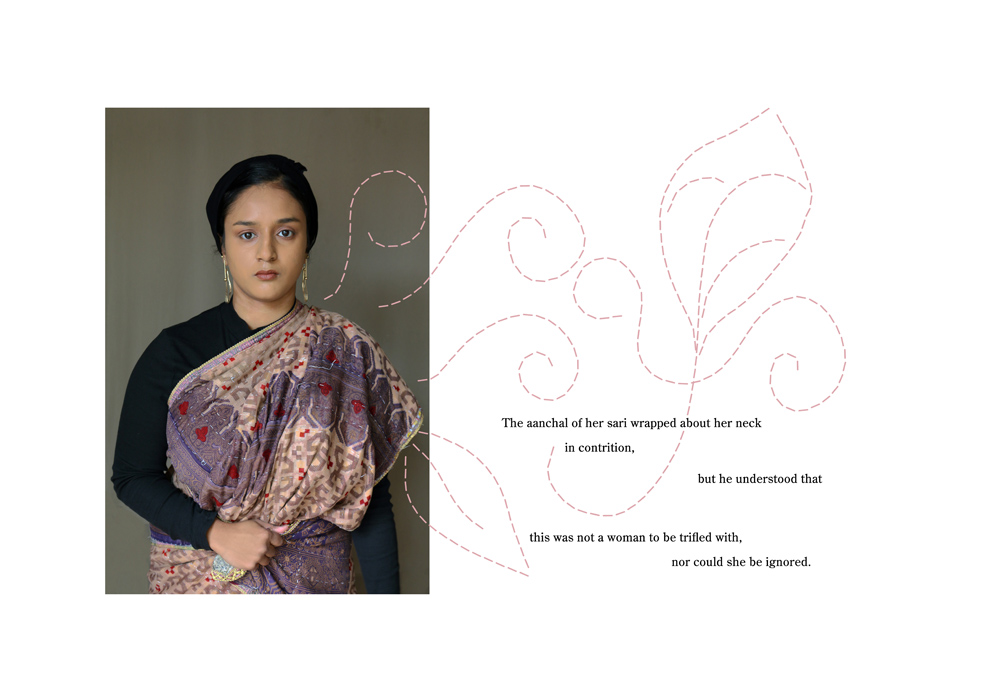
©Nilupa Yasmin, Soudamini Mother told me stories 2022, A kantha is an embroidered quilt made from scraps of cloth, intricately hand-stitched. Women in Bangladesh make kanthas for their families, to pass down and as a source of independent income. The British Raj attempted to abolish the Indian cotton trade in 1876, and later tried to police what was allowed to be stitched into the layers of fabric. A native craft that was suppressed under colonial rule becomes an integral production method in these images and the stories these women hold. This series traces the revival of the kantha in postcolonial India, hand stitched through the eyes of 10 individual women from the tales written by Rabindranath Tagore. The patterns in this image are of a running stitch, similar to those created in kantha’s in Bangladesh.
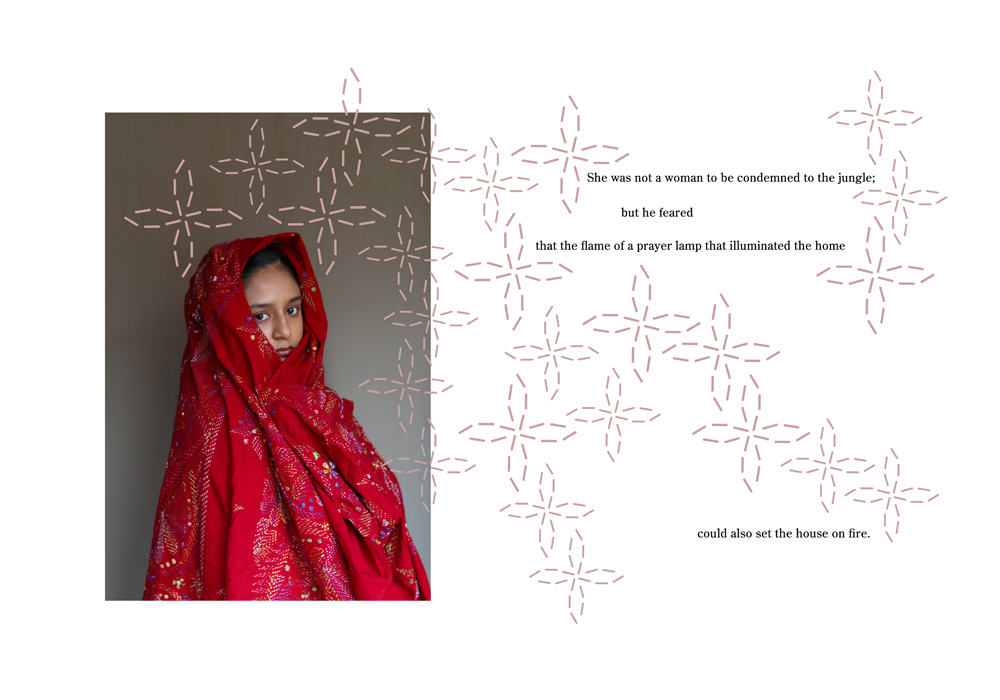
©Nilupa Yasmin, Mrinmaiy Mother told me stories 2022 A kantha is an embroidered quilt made from scraps of cloth, intricately hand-stitched. Women in Bangladesh make kanthas for their families, to pass down and as a source of independent income. The British Raj attempted to abolish the Indian cotton trade in 1876, and later tried to police what was allowed to be stitched into the layers of fabric. A native craft that was suppressed under colonial rule becomes an integral production method in these images and the stories these women hold. This series traces the revival of the kantha in postcolonial India, hand stitched through the eyes of 10 individual women from the tales written by Rabindranath Tagore. The patterns in this image are of a running stitch, similar to those created in kantha’s in Bangladesh.
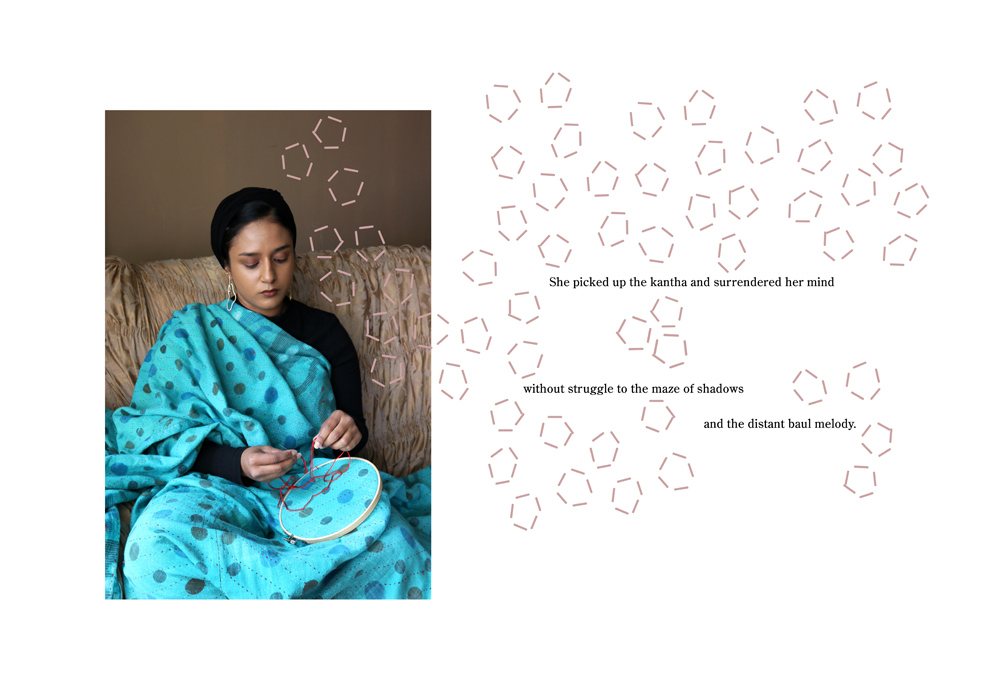
©Nilupa Yasmin, Kalyani Mother told me stories 2022 A kantha is an embroidered quilt made from scraps of cloth, intricately hand-stitched. Women in Bangladesh make kanthas for their families, to pass down and as a source of independent income. The British Raj attempted to abolish the Indian cotton trade in 1876, and later tried to police what was allowed to be stitched into the layers of fabric. A native craft that was suppressed under colonial rule becomes an integral production method in these images and the stories these women hold. This series traces the revival of the kantha in postcolonial India, hand stitched through the eyes of 10 individual women from the tales written by Rabindranath Tagore. The patterns in this image are of a running stitch, similar to those created in kantha’s in Bangladesh.
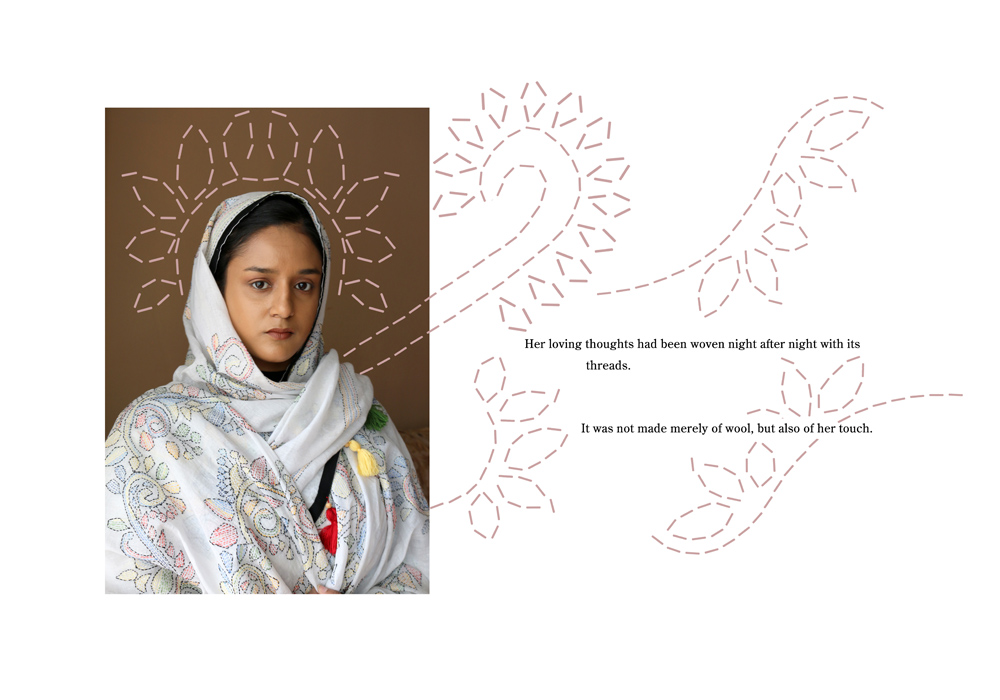
©Nilupa Yasmin, Giribala Mother told me stories 2022 A kantha is an embroidered quilt made from scraps of cloth, intricately hand-stitched. Women in Bangladesh make kanthas for their families, to pass down and as a source of independent income. The British Raj attempted to abolish the Indian cotton trade in 1876, and later tried to police what was allowed to be stitched into the layers of fabric. A native craft that was suppressed under colonial rule becomes an integral production method in these images and the stories these women hold. This series traces the revival of the kantha in postcolonial India, hand stitched through the eyes of 10 individual women from the tales written by Rabindranath Tagore. The patterns in this image are of a running stitch, similar to those created in kantha’s in Bangladesh.
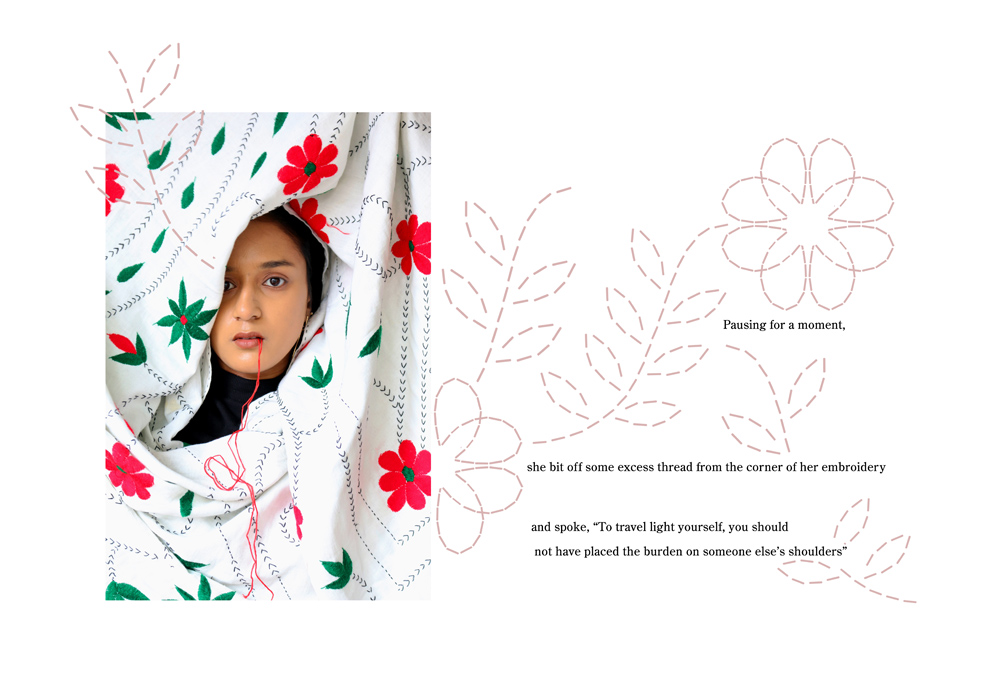
©Nilupa Yasmin, Binodini Mother told me stories 2022 A kantha is an embroidered quilt made from scraps of cloth, intricately hand-stitched. Women in Bangladesh make kanthas for their families, to pass down and as a source of independent income. The British Raj attempted to abolish the Indian cotton trade in 1876, and later tried to police what was allowed to be stitched into the layers of fabric. A native craft that was suppressed under colonial rule becomes an integral production method in these images and the stories these women hold. This series traces the revival of the kantha in postcolonial India, hand stitched through the eyes of 10 individual women from the tales written by Rabindranath Tagore.The patterns in this image are of a running stitch, similar to those created in kantha’s in Bangladesh.
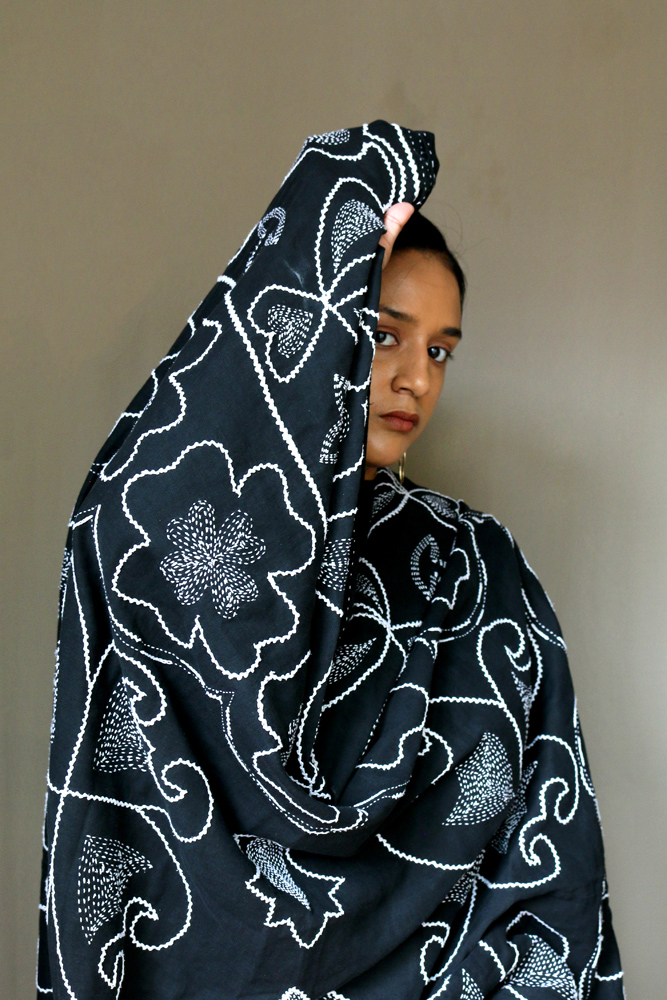
©Nilupa Yasmin, Charulatta Mother told me stories 2022 A kantha is an embroidered quilt made from scraps of cloth, intricately hand-stitched. Women in Bangladesh make kanthas for their families, to pass down and as a source of independent income. The British Raj attempted to abolish the Indian cotton trade in 1876, and later tried to police what was allowed to be stitched into the layers of fabric. A native craft that was suppressed under colonial rule becomes an integral production method in these images and the stories these women hold. This series traces the revival of the kantha in postcolonial India, hand stitched through the eyes of 10 individual women from the tales written by Rabindranath Tagore.
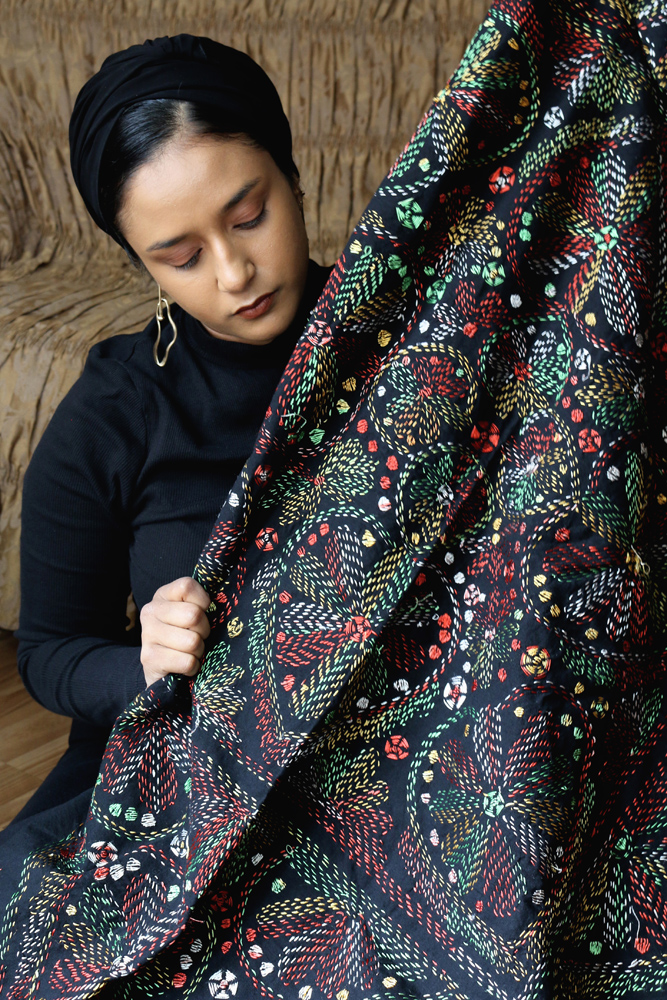
©Nilupa Yasmin, Bimala Mother told me stories 2022 A kantha is an embroidered quilt made from scraps of cloth, intricately hand-stitched. Women in Bangladesh make kanthas for their families, to pass down and as a source of independent income. The British Raj attempted to abolish the Indian cotton trade in 1876, and later tried to police what was allowed to be stitched into the layers of fabric. A native craft that was suppressed under colonial rule becomes an integral production method in these images and the stories these women hold. This series traces the revival of the kantha in postcolonial India, hand stitched through the eyes of 10 individual women from the tales written by Rabindranath Tagore. The patterns in this image are of a running stitch, similar to those created in kantha’s in Bangladesh.
About Alayna N. Pernell, Artist and Educator, The University of Wisconsin-Milwaukee & Milwaukee Artist Resource Network:
Alayna N. Pernell (b. 1996) is a visual artist, writer, and educator from Heflin, Alabama. In May 2019, she graduated from The University of Alabama where she received her Bachelor of Arts in Studio Art with a concentration in Photography and a minor in African American Studies. She received her MFA in Photography from the School of the Art Institute of Chicago in May 2021. Pernell’s practice examines the harsh realities and complexities experienced by Black American women and simultaneously creates space for productive dialogue by enacting an ethic of care, respect, and grace. Her work has been exhibited in various cities across the United States, including FLXST Contemporary (Chicago, IL), Refraction Gallery (Milwaukee, WI), JKC Gallery (Trenton, NJ), RUSCHWOMAN Gallery (Chicago, IL), Colorado Photographic Arts Center (Denver, CO), Griffin Museum of Photography (Winchester, MA), The Sheldon (St. Louis, MO) and more.
Pernell was named the 2020-2021 recipient of the James Weinstein Memorial Award by the School of the Art Institute of Chicago Department of Photography, the 2021 Snider Prize recipient by the Museum of Contemporary Photography and a 2023 Mary L. Nohl Fellowship recipient. She was also recognized on the Silver Eye Center of Photography 2022 Silver List, Photolucida’s 2021 Critical Mass Top 50, 2021 Lenscratch Student Prize Honorable Mention, and more.
Instagram: @alaynapernell
Las Fotos Project’s mission is to elevate the voices of teenage girls and gender-expansive youth from communities of color through photography and mentoring, empowering them to channel their creativity for the benefit of themselves, their community, and future careers.
Las Fotos Project was launched to provide opportunities for those who are both systemically and socially silenced to make themselves heard and, in the process, advocate for social change and create their own pathways to successful, creative futures. Our program model further reinforces photography’s inherent ability to spark introspection, evoke deeper meaning, and serve as a catalyst for change by placing students at the heart of social justice efforts in their respective communities.
Las Fotos Project was founded in 2010 by Los Angeles-based photographer Eric V. Ibarra after seeing a need for teenage girls throughout Los Angeles to have a skill that could help build their confidence and self-esteem. In March of 2011, Las Fotos Project became a project of Community Partners, a 501(c)3 organization which accelerates ideas into action to advance the public good. Las Fotos Project has since worked with girls throughout Southern California, and has developed partnership with national and international nonprofit organizations and schools to expand the movement of inspiring teenage girls through photography and self-expression. Our current focus is on the Central, South, and East Los Angeles regions of Los Angeles.
Posts on Lenscratch may not be reproduced without the permission of the Lenscratch staff and the photographer.
Recommended
-
The 2024 Lenscratch Student Prize Honorable Mention Winner: Andrew ZouJuly 26th, 2024
-
The 2024 Lenscratch Student Prize Honorable Mention Winner: Anh NguyenJuly 25th, 2024
-
The 2024 Lenscratch 3rd Place Student Prize Winner: Mehrdad MirzaieJuly 24th, 2024
-
The 2024 Lenscratch 2nd Place Student Prize Winner: Ariana GomezJuly 23rd, 2024
-
The 2024 Lenscratch 1st Place Student Prize Winner: Mosfiqur Rahman JohanJuly 22nd, 2024

